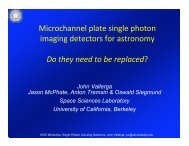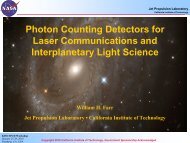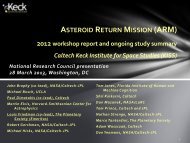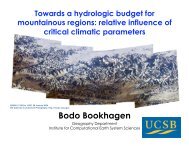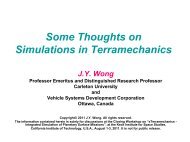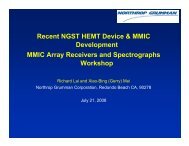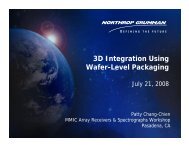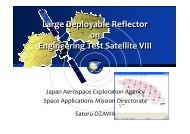Target NEO: Open Global Community NEO Workshop Report
Target NEO: Open Global Community NEO Workshop Report
Target NEO: Open Global Community NEO Workshop Report
You also want an ePaper? Increase the reach of your titles
YUMPU automatically turns print PDFs into web optimized ePapers that Google loves.
DRAFT: RELEASED FOR PUBLIC COMMENT4.4 <strong>NEO</strong> Proximity OperationsWhile operations around a given <strong>NEO</strong> will be a function of that body’s specific gravity field, size,etc., dynamical modeling suggests that regardless of those parameters, a range of solutions willexist. The weak, irregular gravitational field likely presented by a <strong>NEO</strong> means that arbitrarilychosen <strong>NEO</strong>-captured orbits will not necessarily be naturally stable, and would therefore requirefrequent maintenance maneuvering. However, relatively stable orbits do exist, mostly within theterminator plane with orbit radii equal to a few <strong>NEO</strong> radii. Another option is for the spacecraftto stationkeep near the <strong>NEO</strong> and view its sunlit surface area over the course of the <strong>NEO</strong>’s day(likely 4 to 12 hours). Stationkeeping nearby may be a particularly attractive option for <strong>NEO</strong>swith binary companions, as such companions would likely occupy the <strong>NEO</strong>’s stable orbit regions.Close proximity operations can also be achieved through a series of slow hyperbolic flybys to andfrom a standoff position. These operations, affected by the microgravity regime, unstable orbitalmechanics, and extreme <strong>NEO</strong> environments, are not like those currently used in LEO by the Shuttlerelative to the International Space Station (ISS).4.5 <strong>NEO</strong> <strong>Target</strong> Selection ConsiderationsEngineering, dynamical, and human factor constraints will limit the pool of viable <strong>NEO</strong>s for explorationby human crews. The size-frequency distribution of <strong>NEO</strong>s is such that as smaller objectsizes are considered, the number of expected objects increases exponentially. However, smaller sizesare also much more likely to have rotation rates too fast to allow safe interaction. From a scientificpoint of view, in-depth exploration of any asteroid will represent a major leap in our understanding,and we are not likely to have a large enough pool of well-characterized targets to use sciencepreferences as a discriminator between objects. Therefore, we expect non-scientific factors, such ascrew safety and accessibility, to be the major criteria for target selection.4.6 Summary of Key Findings1. <strong>NEO</strong>s show a wide range of diversity in physical characteristics of interest for future humanexploration. Some constraints are already well understood, but more data on the populationas a whole is still necessary.2. Characterization of candidate <strong>NEO</strong> targets should include information applicable for humanexploration needs, including rotation period and pole direction, size, shape, presence of satellites,composition, and internal structure. In addition, an understanding of regolith propertiesand dynamics will be critical.3. Robotic precursor missions are required for detailed in situ physical characterization of candidatehuman spaceflight targets to reduce operational and budgetary risk. Remote sensingobservations can provide some needed data but cannot meet anticipated needs for constraintson regolith mechanical properties, internal structure, or surface particle interactions. Remotesensing opportunities are also infrequent and may not support human mission opportunitieswith sufficient lead time.DRAFT: RELEASED FOR PUBLIC COMMENT 15




